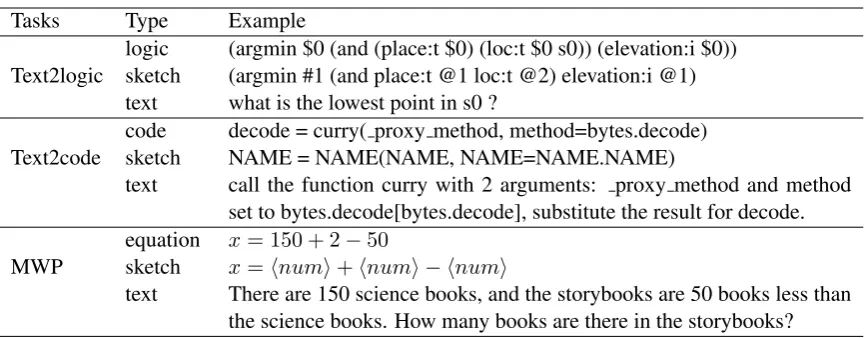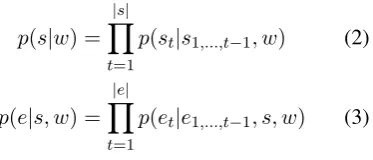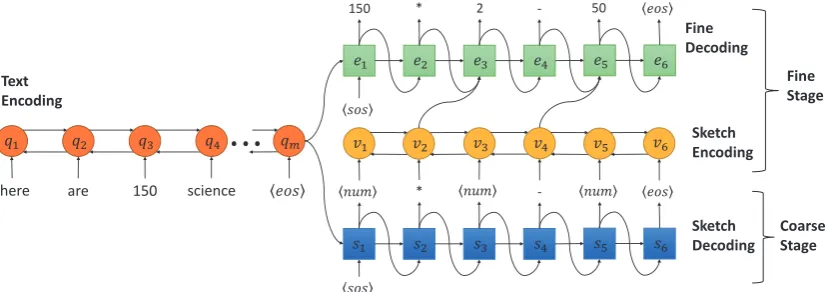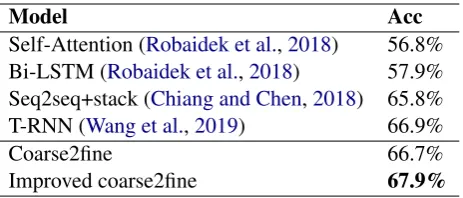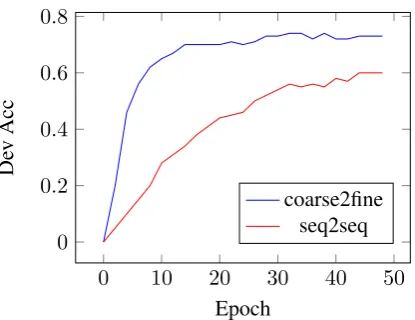An Improved Coarse-to-Fine Method for Solving Generation Tasks
Wenyu Guan1,2, Qianying Liu3, Guangzhi Han2, Bin Wang4 and Sujian Li1 1 Key Laboratory of Computational Linguistics, MOE, Peking University
2 School of Software and Microelectronics, Peking University 3Graduate School of Informatics, Kyoto University
4Xiaomi AI Lab, Xiaomi Inc.
{guanwy, hanguangzhi10, lisujian}@pku.edu.cn ying@nlp.ist.i.kyoto-u.ac.jp, wangbin11@xiaomi.com
Abstract
The coarse-to-fine (coarse2fine) methods have recently been widely used in the generation tasks. The methods first generate a rough sketch in the coarse stage and then use the sketch to get the final result in the fine stage. However, they usually lack the correction abil-ity when getting a wrong sketch. To solve this problem, in this paper, we propose an improved coarse2fine model with a control mechanism, with which our method can con-trol the influence of the sketch on the final re-sults in the fine stage. Even if the sketch is wrong, our model still has the opportunity to get a correct result. We have experimented our model on the tasks of semantic parsing and math word problem solving. The results have shown the effectiveness of our proposed model.
1 Introduction
The coarse-to-fine (coarse2fine) methods have been applied in many generation tasks such as machine translation (Xia et al., 2017) , abstract writing (Wang et al., 2018b) and semantic pars-ing (Dong and Lapata, 2018). They have shown excellent performances but still have many disad-vantages. Traditional coarse2fine models usually tackle one task in two stages. In the first stage (coarse stage), a low-level seq2seq model is used to generate a rough sketch, which makes the data more compact and alleviates the problem of data sparsity. Some examples of sketches are shown in Table 1. Besides, Sketches in this stage are also easier to generate. Then, in the fine stage, both text and previous sketches will be input to another high-level seq2seq model to predict the final result so that the high-level model can produce a precise output.
In the coarse2fine models, the concept of tem-plate sketch provides a new view of compiling a
rough template, but how to guarantee its quality is still a problem. Meanwhile, details from the fine stage will be filled into sketches to produce the final result, so the quality of sketches serves an essential influence on the result. If the generated sketches are in high quality, the coarse2fine model performs well. Otherwise, we fail to get an excel-lent output. The main reason is that the sketch is misleading and has no possibility to be corrected once it is wrong.
In this paper, we propose an improved coarse2fine model to solve this problem. It has a similar framework which consists of two levels of seq2seq models. First, the model predicts a rough sketch in the coarse stage. In the fine stage, com-pared with traditional coarse2fine model, we use the generated sketches in the coarse stage as as-sistant information to help the decoder. Besides, We set a weight to control the degree of how the sketch affects the fine stage. Higher weight means that the fine stage is strictly guided by the sketch. Lower weight will decrease the impact of the sketch on the final output and give the model more flexibility to generate the result which does not rely on the sketch. For different tasks, we will tune the weights by experience and make a bal-ance between the sketch guidbal-ance and the model’s correction ability.
Our model is a universal framework which can apply on many generation tasks. In this work, we apply it on two semantic parsing tasks (text2logic and text2code) and math word problem (MWP) solving task. Experimental results show that our model achieves a better performance than some baseline models in these tasks.
2 Related Work
Tasks Type Example
Text2logic
logic (argmin $0 (and (place:t $0) (loc:t $0 s0)) (elevation:i $0)) sketch (argmin #1 (and place:t @1 loc:t @2) elevation:i @1) text what is the lowest point in s0 ?
Text2code
code decode = curry( proxy method, method=bytes.decode) sketch NAME = NAME(NAME, NAME=NAME.NAME)
text call the function curry with 2 arguments: proxy method and method set to bytes.decode[bytes.decode], substitute the result for decode.
MWP
equation x= 150 + 2−50
sketch x=hnumi+hnumi − hnumi
[image:2.595.83.517.59.228.2]text There are 150 science books, and the storybooks are 50 books less than the science books. How many books are there in the storybooks?
Table 1: Examples of text, sketches and generating goals in different datasets.
method we applied.
2.1 Semantic Parsing
Semantic parsing is a task of translating natu-ral language into computer executable language such as logic form, code in computer language and SQL query. Traditional semantic parsing usu-ally adopts rule based methodTang and Mooney
(2000);Wong and Mooney(2007);Andreas et al.
(2013). Recently, with the development of neu-ral network techniques, there are many new se-mantic parsing models with neural methods. Of them, Seq2seq models have been widely applied in semantic parsing tasks. The encoder encodes the text and the decoder predicts the logic sym-bols (Dong and Lapata, 2016). The seq2tree model encodes inputs by LSTM and generates the logic form by conditioning the output sequences or trees on the encoding vectors.(Dong and Lap-ata,2016). Abstract syntax networks (ASN) repre-sent the output as the abstract syntax trees (ASTs) (Rabinovich et al., 2017). Its decoder uses a dynamically-determined modular structure paral-leling the structure of the output tree.
2.2 Math Word Problem
Math word problem (MWP) aims to teach comput-ers to read the questions in natural language and generate the corresponding math equations. The methods of solving math word problems can be mainly classified into two categories. The first cat-egory is the template-based models which summa-rize some templates through locating similar ques-tions from a given dataset and then fill the con-crete numbers into the templates to solve prob-lems (Huang et al., 2017; Wang et al., 2017).
Some cases of math word problems, math equa-tions, templates and sketches are shown in Ta-ble 2 These methods are intuitive, but it is diffi-cult to obtain high-quality templates due to data sparsity and transfer them to other datasets. The second category of methods mainly exploits the seq2seq framework to generate the solution equa-tions (Wang et al., 2018a). Recently this kind of methods have shown outstanding performance without manual feature engineering, but they are prone to generate wrong numbers due to its gen-eration flexibility. Some researches have applied reinforcement learning (Huang et al., 2018) or a stack (Chiang and Chen,2018) to improve the de-coding process.
2.3 Coarse-to-fine method
Generalized coarse-to-fine method divides prob-lems into different stages and solves them from coarse to fine. This method is widely applied in computer vision (Gangaputra and Geman, 2006;
Pedersoli et al.,2011;Wen et al.,2019) and natu-ral language process (Mei et al.,2016;Choi et al.,
2017). The special coarse-to-fine method in this paper is based on end-to-end framework. It has two seq2seq models, generating target data from a coarse stage to a fine stage. Xia et al. (2017) proposedpolish mechanismwith two levels of de-coders. The first decoder generates a raw sequence and the second decoder polishes and refines the raw sentence with deliberation. Their model per-forms excellently on machine translation and text summarization, which is also the first time to use this kind of coarse-to-fine model. Wang et al.
pars-many insects do woodpeckers eat more than frogs every day? Equation x= 645−608/8
Template x=hnum1i − hnum2i/hnum3i
Numbers {hnum1i: 645,hnum2i: 608,hnum3i: 8}
Question The garment factory originally planned to make 1080 sets of suits, which would be completed in 20 days. Actually they finished 72 sets per day, How many sets they produced everyday more than the original plan?
Equation x= 72−1080/20
Template x=hnum3i − hnum1i/hnum2i
Numbers {hnum1i: 1080,hnum2i: 20,hnum3i: 72}
Question The shirt factory produced 640 shirts in the past 4 days, but now it produces 350 shirts per day. How many shirts it produces each day more than it used to ?
Equation x= 350−640/4
Template x=hnum3i − hnum1i/hnum2i
[image:3.595.105.292.595.675.2]Numbers {hnum1i: 640,hnum2i: 4,hnum3i: 350} Sketch x=hnumi − hnumi/hnumi
Table 2: Examples of math word problems with different equations but same sketches.
ing, Dong and Lapata(2018) applied a two-level coarse-to-fine model in text2logic, text2python and text2SQL. This framework also shows signif-icant improvement in these parsing tasks.
3 Problem Formulation
In this work, we aim at generating structured lan-guages. Each instance contains a piece of text in natural language withmwords{wi}m1 , generating
the target output{ei}|1e|. We learn sketches{si}|1s| from{wi}m1 . We decompose the probability
distri-butionp(e|w)into a combination of sketch’s con-ditional probability:
p(e|w) =p(e|s, w)p(s|w) (1)
In this paper, we compute p(e|s, w) and p(s|w) step by step:
p(s|w) =
|s| Y
t=1
p(st|s1,...,t−1, w) (2)
p(e|s, w) =
|e| Y
t=1
p(et|e1,...,t−1, s, w) (3)
3.1 Framework
The coarse2fine model consists of four main com-ponents: text encoder, sketch decoder, sketch en-coder, and final decoder.
During the coarse stage, the text encoder and sketch decoder predicate sketch by computing
p(s|w)step by step. Then, in fine stage, the sketch encoder will encode the sketch and the decoder takes the text encoder’s output and sketch to com-pute the probability distribution. The framework is shown in Figure1.
3.2 Coarse Stage
In the coarse stage, a basic seq2seq architecture is used to generate sketches. Firstly, question text is split into tokens and sent into an embedding layer. Then, a two-layer bidirectional LSTM (Hochreiter and Schmidhuber, 1997) will read the embedded word one-by-one and produce a sequence of hid-den states{qi}m1 :
qfi =LST M(emb(wi), qif−1) (4)
qbi =LST M(emb(wi), qib+1) (5)
qi = [qif, qib] (6)
mech-ݍଵ ݍଶ ݍଷ ݍସ ݍ
ݏଵ ݏଶ ݏଷ ݏସ ݏହ ݏ
ݒଵ ݒଶ ݒଷ ݒସ ݒହ ݒ
݁ଵ ݁ଶ ݁ଷ ݁ସ ݁ହ ݁
ڮ
݊ݑ݉ * ݊ݑ݉ - ݊ݑ݉ ݁ݏ
ݏݏ ݏݏ
150 * 2 - 50 ݁ݏ
there are 150 science ݁ݏ
Fine Decoding
Sketch Decoding Sketch Encoding Text
Encoding
Fine Stage
[image:4.595.88.504.69.215.2]Coarse Stage
Figure 1: Improved Coarse-to-Fine Model framework.
anism:
hj =LST M(emb(sj−1), hj−1)
(7)
aji =sof tmax(qihj) (8)
cj = m
X
i=0
ajihj (9)
p(sj|s1,...,j−1, w) =sof tmax(U[tanh(
W[cj;hj] +battn)] +b) (10)
hj is the decoder hidden state inj step,aji is the attention score, cj is the context vector. Beyond that,U, W, battnandbare model’s parameters.
3.3 Fine Stage
In this stage, the fine decoder uses the sketch as assistant information to predict the final result. At the beginning of the fine stage, a bidirectional LSTM is used as sketch encoder to encode the sketch. After taking the encoded sketch as a part of the input, the fine decoder has perceptions of the whole sketch in low-level meaning. The pro-cess of sketch encoding is similar to question en-coding, while the difference is that the input of (4) and (5) are changed to sketch symbols{si}|1s|.
Then, the fine decoder will use the encoded sketch to help its decoding process. As shown in Figure 1, fine decoder shares the same common text encoder with sketch decoder. The decoding process of fine stage is also similar to sketch de-coding (7)-(10), but the input of LSTM is designed
as follows:
it=
λ·vt−1+ (1−λ)emb(et−1),
et−1is determined byst−1
emb(et−1), otherwise
(11)
ht=LST M(it, ht−1) (12)
Ifet−1is determined byst−1, the input is the
com-bination of the embedding ofet−1 and the sketch
encoder’s outputvt−1. Otherwise, it is set as the
embedding of et−1. We assume the number of
sketch decoding outputs is the same shape as the ones from fine decoding. So theetand the stare aligned one by one. λ is a hyper parameter that controls the combination ofvt−1 andemb(et−1),
ranging from 0 to 1. It indicates how much the fine decoder is guided by sketches. Ifλis 1, the pro-cess of fine decode will be strictly guided by the sketch. Once the sketch is wrong, the fine decoder has little possibilities to generate a correct result. On the contrary, if λ is 0, the coarse stage will become useless and our model will degrade into one stage model. Like equations (7)-(10), we com-pute the final probability distribution according to
wandsstep by step. Andp(et|e1,...,t−1, s, w)is
calculated analogously equation (10).
3.4 Model Training
aims to maximizeL:
L=Lske+Lres (13)
Lske=
X
(s,w)
logp(s|w) (14)
Lres=
X
(s,w,e)
logp(e|s, w) (15)
(s, w, e) belongs to training pairs. When the model is in testing mode, the final result is com-puted according ˆs = arg maxs0p(s
0
|w)andeˆ = arg maxe0p(e
0
|w, s). s0 ande0 are sketch candi-dates and result candicandi-dates.
4 Experiments
4.1 Dataset
Text-to-LogicIn this task, we conduct our model on GEO dataset, which contains 880 sentences and their corresponding logical queries. Follow-ing Dong and Lapata(2018)’s work, we extract the sketches fromλ-calculus-based meaning rep-resentations. These sketches ignore the arguments and variables and concentrate on operators and logic structures. ”$” means an ignored argument and ”#” represents an omitted token.
Text-to-CodeWe chose the Django dataset which has 18805 pairs of natural language expression texts and python codes. We get the sketches by re-placing the objects, numbers, functions, and vari-ables with their type names. The symbols of the basic framework are reversed, such as keyword and operators.
MWPMath23k is one of the most popular math word problem datasets which has 23,162 Chinese algebra problems. Each item contains a ques-tion in Chinese, a math equaques-tion and a answer to the question. To get sketches, we use a place-holder hnumi to replace the detail numbers in math equations, so sketches only include operators (”+-*/”) and hnumi. Another large-scale MWP dataset is Dolphin23K, but its authors just release a construction tool, so we can’t get the standard data. All the experiments on it are finished by the dataset’s author and they never release the code. Because we can’t evaluate the result fairly, we give up conducting our experiment on Dolphin23K. Examples of original data and sketches of these three datasets are shown in Table1.
[image:5.595.122.293.96.174.2]GEO 600 100 180 Django 16000 1000 1805 Math23k 21162 1000 1000
Table 3: Statics of datasets
Task Emb Hidden Epoch LR
Text2logic 150 250 50 0.005 Text2code 200 300 150 0.005
MWP 128 512 150 0.01
Table 4: Model parameters and training settings
4.2 Preprocess
To compare the result equally, we made our preprocessing in accord with Dong and Lapata
(2018)’s experiment as much as possible. For GEO, we followedDong and Lapata’s work, trans-forming all words into lower type and replacing the entity mentions with a sign and a counting number. And for Django, we chosed to use the processed data given by Yin and Neubig (2017). They tokenized and POS tagged sentences using NLTK. In MWP, we followedWang et al.’s work. To reduce the influence of OOV, we normalized numbers as the order of their appearance. Ex-amples of some processed cases of Math23k are shown in Table2, who have same sketches.
4.3 Results
We has compared our improved coarse2fine model with different published models. The optimizer is Adam and many details of training and testing are shown in Table3and Table4. To compare the re-sult equally, we chose the same model parameters as Dong and Lapata (2018) in semantic parsing tasks. Accuracy in this paper (except the MWP) is calculated by comparing the generated result to the gold result(sketches, logic expressions and Python codes), while, in MWP, the accuracy means that whether the math formula predicated by our model it is equal to the given answer.
The results of text2logic are presented in Table
ex-Model Acc
Seq2seq (Dong and Lapata,2016) 84.6% Seq2tree (Dong and Lapata,2016) 87.1% Asn (Rabinovich et al.,2017) 85.7% Asn+supatt (Rabinovich et al.,2017) 87.1%
One stage 85.0%
[image:6.595.309.541.61.160.2]Coarse2fine (Dong and Lapata,2018) 88.2% Improved coarse2fine 88.6%
Table 5: Results of text2logic on GEO
Model Acc
Seq2seq+unk replacement 45.1% Seq2tree+unk replacement 39.4% Lpn+copy (Ling et al.) 62.3% Snm+copy (Yin and Neubig,2017) 71.6%
One stage 69.5%
Coarse2fine (Dong and Lapata,2018) 74.1% Improved coarse2fine 76.1%
Table 6: Results of text2code on Django
periment, the sketch decoder can get 89.3% accu-racy and the highest accuaccu-racy of logic expression is 88.6% whenλis 0.9. Compared to Dong and Lapata’s model, our accuracy rise by 0.4%.
Table 6 reports the results of text2code task. The accuracy of sketches in this task is 77.4%. First two lines areDong and Lapata’s experiments with seq2seq model and seq2tree model. In ad-dition, Ling et al. has designed Latent-Predictor-Network with copy mechanism. And a syntac-tic neural model also shows good performance in code generation (Yin and Neubig, 2017). As we can see, our model has an outstanding perfor-mance in Django dataset. We achieve 76.1% ac-curacy whenλis 0.6.
The results of MWP are shown in Table 7. As mentioned in Section 2.2, models can be classi-fied into various categories according to the way they get the equation. Classification models get templates through classifier based on Bi-LSTM or Self-Attention (Robaidek et al.,2018). Generation models get equations based on seq2seq models. They are improved with many assistant compo-nents. Chiang and Chen (2018) has used a stack, so they could build a tree structure math formula by pushing and popping generated items. Wang et al.(2019) has designed a template-based model which could predict the tree structure formula from bottom to up. In our experiment, sketches have 68.3% accuracy, whereas the accuracy of our
Model Acc
Self-Attention (Robaidek et al.,2018) 56.8% Bi-LSTM (Robaidek et al.,2018) 57.9% Seq2seq+stack (Chiang and Chen,2018) 65.8% T-RNN (Wang et al.,2019) 66.9%
Coarse2fine 66.7%
Improved coarse2fine 67.9%
Table 7: Result of MWP on Math 23K.
model reaches 67.9% whenλis 0.3.
4.4 Further Test and Analysis
We present the performance with different hyper parameter λ in Table 8. For semantic parsing tasks, our model has a more obvious improvement in text2code. Whenλis 1, the model is equal to
Dong and Lapata’s model and it has 74.9% ac-curacy. With the decrease of λ, the influence of sketch declines. In the range of (1, 0.6), the lower
λgives the fine decoder more chances to generate a correct result. Whenλis lower than 0.6, correct sketches’ help will be decreased, which leads to a poor result . The model should keepλin a ap-propriate value, so it can take coarse2fine model’s advantage and have chances to predict a correct result even the sketch is wrong.
We are the first one to apply coarse2fine method in MWP task. To check whether using sketches makes a good contribution to this task, we sus-pend the coarse stage and give gold sketches to sketch encoder1. The hyper parameterλis set to 1 so the equation generation will be strictly guided by the sketch. We compared it with one stage model (Wang et al., 2018a). As shown in Fig-ure2, our model can improve its accuracy highly and shows faster convergence speed after applying gold sketches. Also, its accuracy hits 77.0% under such circumstances.
5 Conclusions
We propose an improved coarse-to-fine generating model in this paper, which takes the advantages of using sketches to help the generating process. When the sketches have mistakes, our model still has a chance to generate a correct result, which will be conducive to the final accuracy. Besides, it is a general framework for many tasks and easy
1Giving gold sketches to the sketch encoder in the former
[image:6.595.72.291.62.182.2]Text2logic 88.2% 88.5% 87.8% 86.5% 85.2% Text2django 74.9% 76.0% 76.1% 75.2% 74.9% MWP 66.7% 66.9% 67.4% 67.8% 67.8%
Table 8: Accuracy of three tasks with different hyper parameters.
0 10 20 30 40 50
0 0.2 0.4 0.6 0.8
Epoch
De
v
Acc
coarse2fine seq2seq
Figure 2: Training record of coarse2fine model and seq2seq model.
to follow. We have conducted our model in many generation tasks (text2logic, text2code, MWP). As a result, compared with the basic model, our accu-racy has increased by 0.4%, 2.0%, 1.2% respec-tively in these three tasks.
Acknowledgments
We thank the anonymous reviewers for their help-ful comments on this paper. This work was partially supported by National Natural Science Foundation of China (61572049 and 61876009). The corresponding author is Sujian Li.
References
Jacob Andreas, Andreas Vlachos, and Stephen Clark. 2013. Semantic parsing as machine translation. In
Proceedings of the 51st Annual Meeting of the As-sociation for Computational Linguistics (Volume 2: Short Papers), pages 47–52.
Ting-Rui Chiang and Yun-Nung Chen. 2018. Semantically-aligned equation generation for solving and reasoning math word problems. arXiv preprint arXiv:1811.00720.
Eunsol Choi, Daniel Hewlett, Jakob Uszkoreit, Illia Polosukhin, Alexandre Lacoste, and Jonathan Be-rant. 2017. Coarse-to-fine question answering for long documents. InProceedings of the 55th Annual Meeting of the Association for Computational Lin-guistics (Volume 1: Long Papers), pages 209–220.
Li Dong and Mirella Lapata. 2016. Language to logi-cal form with neural attention. InProceedings of the 54th Annual Meeting of the Association for Compu-tational Linguistics (Volume 1: Long Papers), vol-ume 1, pages 33–43.
Li Dong and Mirella Lapata. 2018. Coarse-to-fine de-coding for neural semantic parsing. In Proceed-ings of the 56th Annual Meeting of the Association for Computational Linguistics (Volume 1: Long Pa-pers), pages 731–742.
Sachin Gangaputra and Donald Geman. 2006. A design principle for coarse-to-fine classification.
In Proceedings of the 2006 IEEE Computer
So-ciety Conference on Computer Vision and
Pat-tern Recognition-Volume 2, pages 1877–1884. IEEE
Computer Society.
Sepp Hochreiter and J¨urgen Schmidhuber. 1997. Long short-term memory. Neural computation, 9(8):1735–1780.
Danqing Huang, Jing Liu, Chin-Yew Lin, and Jian Yin. 2018. Neural math word problem solver with rein-forcement learning. InProceedings of the 27th In-ternational Conference on Computational Linguis-tics, pages 213–223.
Danqing Huang, Shuming Shi, Chin-Yew Lin, and Jian Yin. 2017. Learning fine-grained expressions to solve math word problems. In Proceedings of the 2017 Conference on Empirical Methods in Natural
Language Processing, pages 805–814.
Wang Ling, Edward Grefenstette, Karl Moritz Her-mann, Tom´aˇs Kocisk`y, Andrew Senior, Fumin Wang, and Phil Blunsom. Latent predictor networks for code generation.
Hongyuan Mei, TTI UChicago, Mohit Bansal, and Matthew R Walter. 2016. What to talk about and how? selective generation using lstms with coarse-to-fine alignment. InProceedings of NAACL-HLT, pages 720–730.
Marco Pedersoli, Andrea Vedaldi, and Jordi Gonz`alez. 2011. A coarse-to-fine approach for fast deformable object detection. InCVPR 2011, pages 1353–1360. IEEE.
[image:7.595.80.288.159.319.2]Benjamin Robaidek, Rik Koncel-Kedziorski, and Han-naneh Hajishirzi. 2018. Data-driven methods for solving algebra word problems. arXiv preprint
arXiv:1804.10718.
Lappoon R Tang and Raymond J Mooney. 2000. Au-tomated construction of database interfaces: Inte-grating statistical and relational learning for seman-tic parsing. InProceedings of the 2000 Joint SIG-DAT conference on Empirical methods in natural language processing and very large corpora: held in conjunction with the 38th Annual Meeting of the As-sociation for Computational Linguistics-Volume 13, pages 133–141. Association for Computational Lin-guistics.
Lei Wang, Yan Wang, Deng Cai, Dongxiang Zhang, and Xiaojiang Liu. 2018a. Translating a math word problem to a expression tree. InProceedings of the 2018 Conference on Empirical Methods in Natural
Language Processing, pages 1064–1069.
Lei Wang, Dongxiang Zhang, Jipeng Zhang, Xing Xu, Lianli Gao, Bingtian Dai, and Heng Tao Shen. 2019. Template-based math word problem solvers with re-cursive neural networks.
Qingyun Wang, Zhihao Zhou, Lifu Huang, Spencer Whitehead, Boliang Zhang, Heng Ji, and Kevin Knight. 2018b. Paper abstract writing through edit-ing mechanism. InProceedings of the 56th Annual Meeting of the Association for Computational Lin-guistics (Volume 2: Short Papers), pages 260–265.
Yan Wang, Xiaojiang Liu, and Shuming Shi. 2017. Deep neural solver for math word problems. In Pro-ceedings of the 2017 Conference on Empirical
Meth-ods in Natural Language Processing, pages 845–
854.
Yang Wen, Bin Sheng, Ping Li, Weiyao Lin, and David Dagan Feng. 2019. Deep color guided coarse-to-fine convolutional network cascade for depth im-age super-resolution. IEEE Transactions on Image Processing, 28(2):994–1006.
Yuk Wah Wong and Raymond Mooney. 2007. Learn-ing synchronous grammars for semantic parsLearn-ing with lambda calculus. In Proceedings of the 45th Annual Meeting of the Association of Computational Linguistics, pages 960–967.
Yingce Xia, Fei Tian, Lijun Wu, Jianxin Lin, Tao Qin, Nenghai Yu, and Tie-Yan Liu. 2017. Deliberation networks: Sequence generation beyond one-pass de-coding. InAdvances in Neural Information Process-ing Systems, pages 1784–1794.
Pengcheng Yin and Graham Neubig. 2017. A syntactic neural model for general-purpose code generation.
In Proceedings of the 55th Annual Meeting of the
